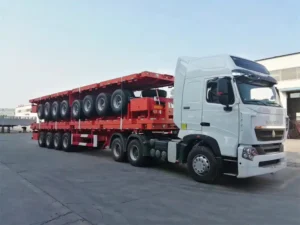Introduction:
Flatbed trailers play a crucial role in transporting a wide array of goods. Like from construction materials and heavy machinery, to oversized cargo and industrial equipment. These versatile trailers are favored for their open design. It allows for easy loading and unloading from the sides or above. Yet, one important aspect of flatbed trailers is their width.
Many people wonder, how wide is a flatbed trailer? The width of a flatbed trailer is a critical factor. It affects transportation regulations, safety, and compatibility with various cargo types. In this article, we will explore the dimensions of flatbed trailers. Its regulations, width, and significance in modern transportation.
Standard Dimensions of Flatbed Trailers

Flatbed trailers come in various sizes, but there are certain standard dimensions. These are observed in most of them. The flatbed trailer width of a standard trailer is around 8.5 feet (102 inches) or 2.6 meters. This width provides enough space to accommodate a single lane of traffic when the trailer is on the road. But, the actual width can vary based on manufacturer specifications and regional regulations.
It’s important to note that 8.5 feet is a common width for flatbed trailers. They can be wider or narrower depending on the specific design and purpose. Some specialized flatbed trailers are designed to be wider to accommodate wider loads. Others might be narrower for specific applications. These variations in width cater to the diverse needs of industries. Some of them are construction, agriculture, and heavy equipment transport. Now that we understood, how wide is a flatbed trailer is let us delve into the factors that decide its width.
Regulations and Permits of Flatbed Trailers
The factor, how wide is a flatbed semi trailer is regulated by transportation authorities. They ensure road safety, prevent accidents, and maintain traffic flow. These regulations vary from country to country. Sometimes even within different states or provinces of a country. In the United States, the Federal Highway Administration (FHWA) sets guidelines. It decides the maximum vehicle width for all cargo vehicles, which includes flatbed trailers.
In the U.S
In the U.S., the maximum legal width for a flatbed trailer is 8.5 feet (102 inches). These trailers don’t need any special permits. This is aligned with the standard width mentioned earlier. However, if a load extends beyond this width, a special oversize load permit is required. The process for obtaining such a permit involves providing detailed information about the load. One should also mention route, and other relevant factors to ensure safe transportation.
Other Countries
Similarly, other countries have their own regulations and permit systems regarding width of a flatbed trailer. These regulations take into account the width of the trailer itself plus the total width. It’s important when considering any load that might extend beyond the trailer’s edges. Compliance with these regulations is crucial to avoid fines, delays, and safety risks.
Wide Loads and Specialized Flatbed Trailers

In cases where the cargo is wider than the standard trailer width, specialized equipment and trailers come into play. Here, the answer to the question, how wide is a flatbed trailer differs a bit. Wide loads are often referred to as oversize or wide-load shipments. They require careful planning and coordination. These loads might include large construction components, prefabricated homes, industrial machinery, and more.
Specialized Flatbed Trailers
For these wide loads, specialized flatbed trailers with extendable or widened decks are used. The flatbed trailer width of these vehicles can be adjusted to accommodate wider cargo. It can be done while still adhering to transportation regulations. Such trailers often feature hydraulic systems. They allow the width of the deck to be extended or retracted as needed.
Challenges and Considerations
Transporting wide loads on flatbed trailers presents several challenges and considerations. One major concern is maintaining stability and balance during transportation. Wider loads can affect the center of gravity. It can potentially lead to issues with trailer tipping or swaying. Hence, proper load distribution, securement, and adherence to weight limits are essential. They help mitigate these risks.
Extra Safety Measures
Furthermore, wider loads might need extra safety measures. Some of them are escort vehicles, warning signs, and pilot cars. Escort vehicles help alert other drivers to the presence of an oversize load on the road. It ensures safe passage and minimizes disruptions to traffic flow.
Innovations and Future Trends of flatbed trailers
As technology continues to advance, the design and capabilities of flatbed trailers are also evolving. Innovations are aimed at improving efficiency, safety, and flexibility. They help in transporting a wide variety of goods.
- Telematics and Tracking Systems
One notable trend is the integration of advanced telematics and tracking systems. These systems provide real-time data. They provide info like the trailer’s location, condition, and the status of the cargo. This enhances transparency for both shippers and carriers. It also enables quicker response to any unforeseen issues during transit.
- Automation and Robotics
Moreover, automation and robotics are making their mark in the transportation industry. And flatbed trailers are no exception. Automated loading and unloading systems are being developed. They help streamline the process and reduce reliance on manual labor. These systems can cut down on loading and unloading times. It enhances operational efficiency.
- Materials
Another area of innovation is materials. Lightweight, high-strength materials are being incorporated into trailer construction. It enables manufacturers to maintain strength while reducing overall weight. This contributes to fuel efficiency and allows for greater payload capacity. There is no need to sacrifice safety.
Conclusion:
In the world of transportation, flatbed trailers are indispensable tools. They cater to a wide range of cargo types and industries. Their width, a critical dimension, has regulations to ensure safety on the road. The standard width of flatbed trailer is around 8.5 feet. Yet, variations exist based on specialized needs and regulatory requirements.
For wide loads and specialized trailers, permits are necessary. These wide-load shipments require careful planning. They need to adhere to safety regulations and proper load securement. As industries continue to evolve transportation needs become more diverse. However, flatbed trailers will remain a vital component of the global logistics network. They need to adapt to accommodate various cargo widths. They should also ensure efficient and secure transportation.
